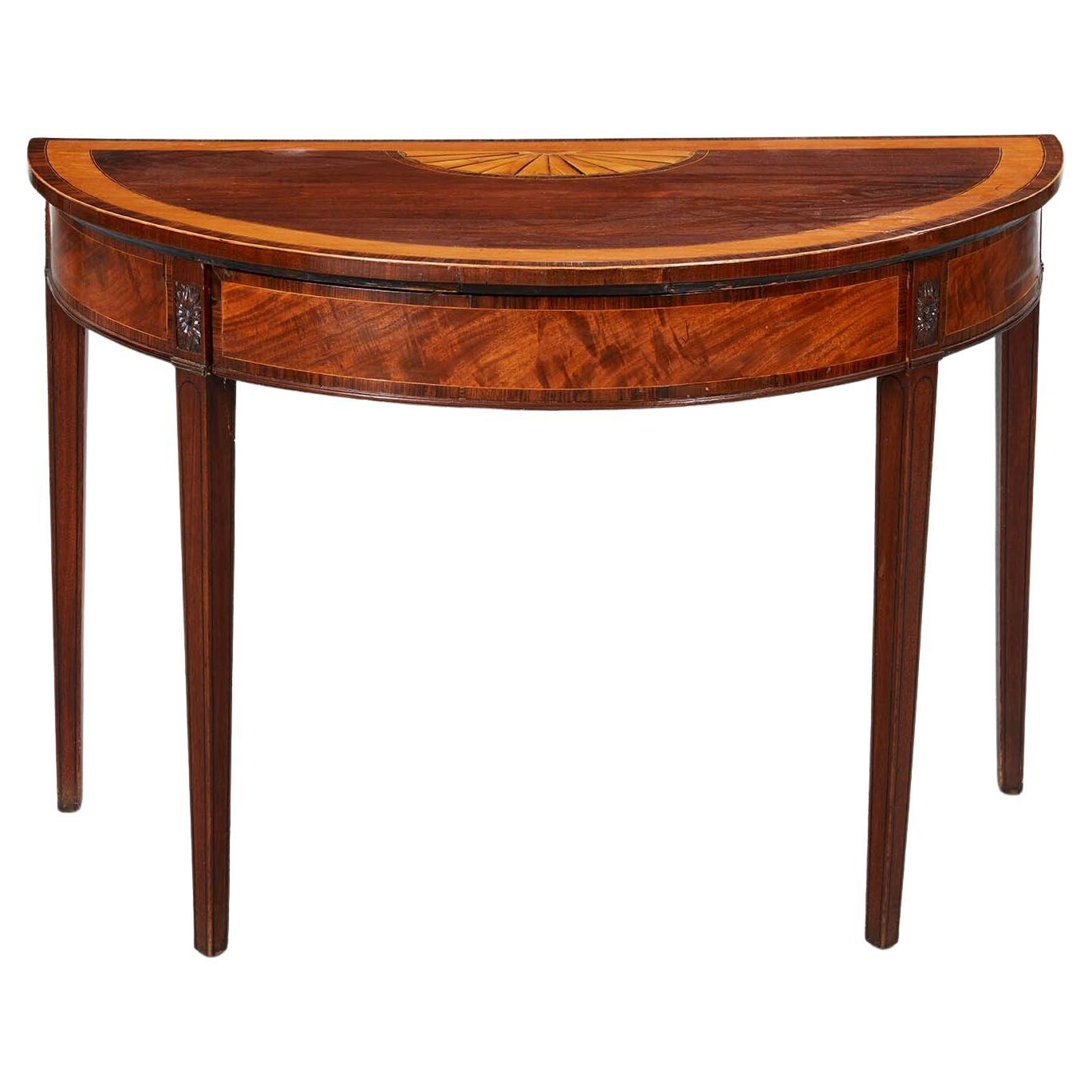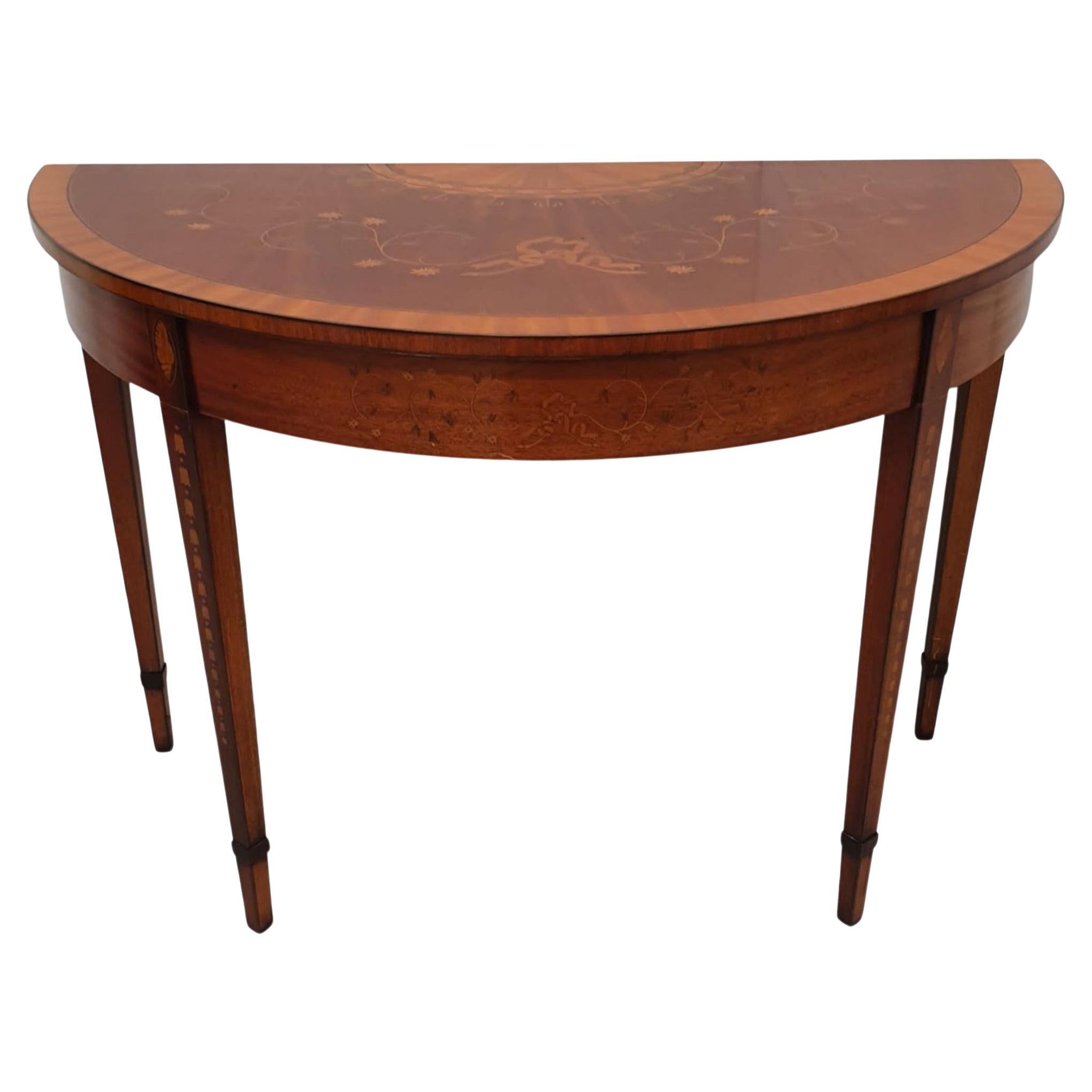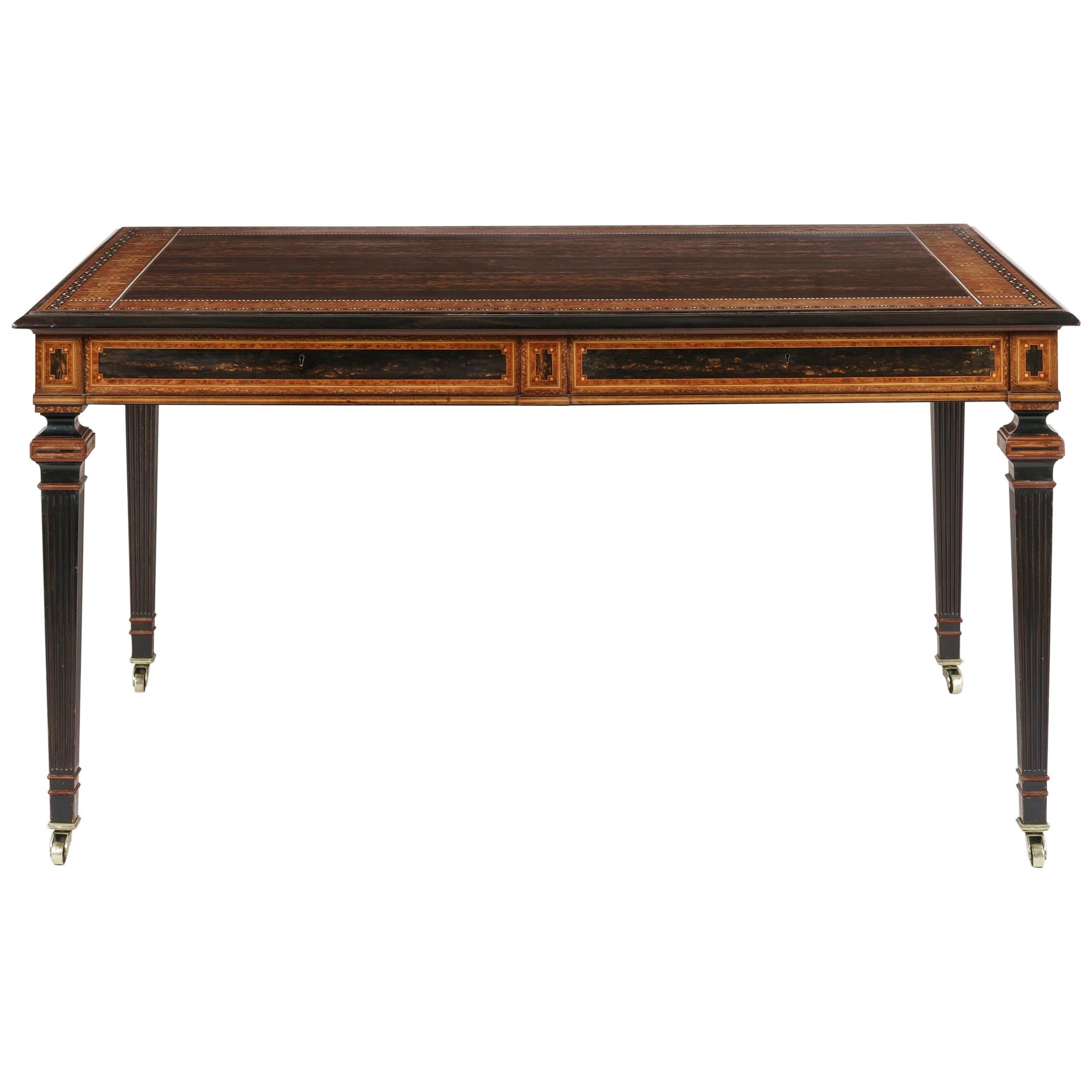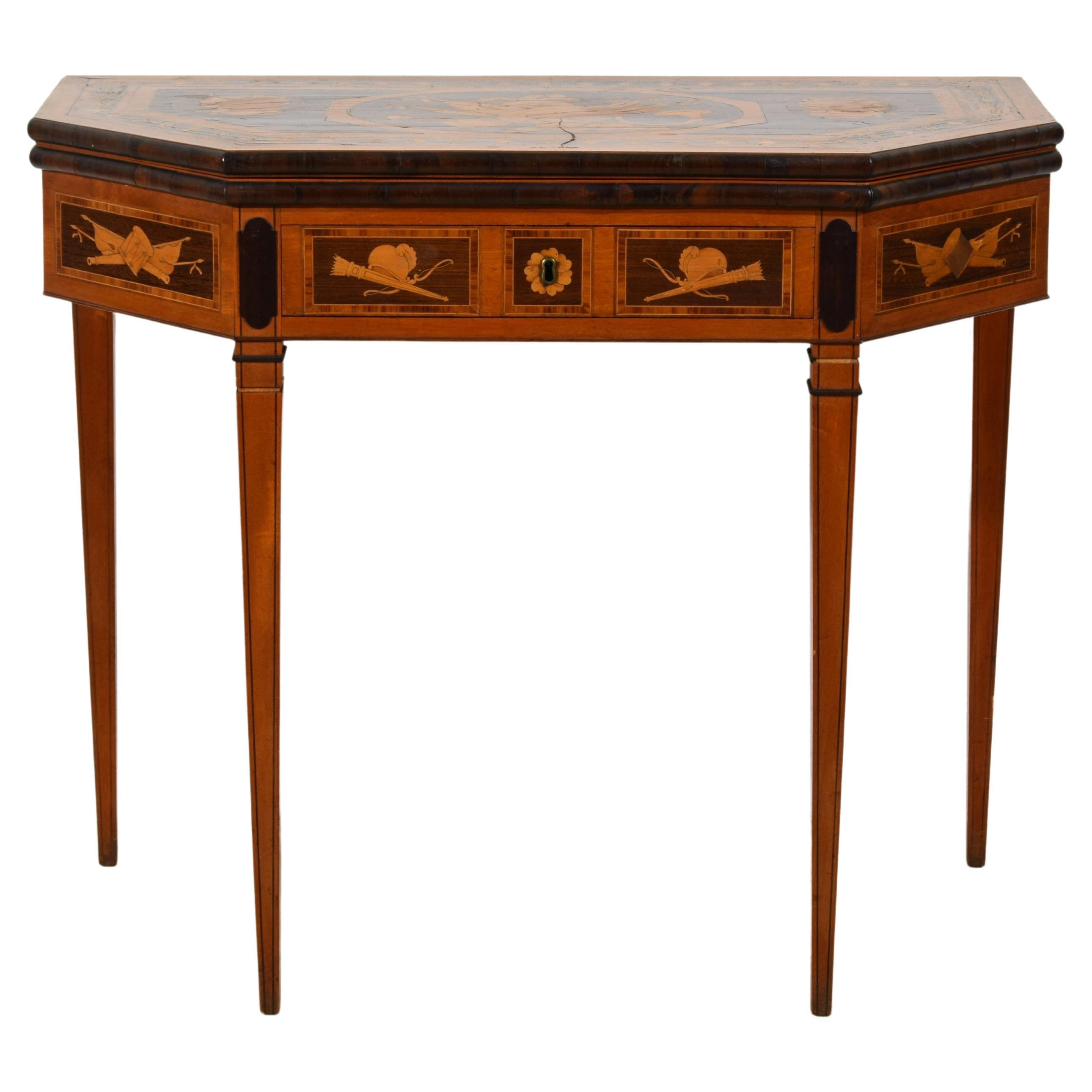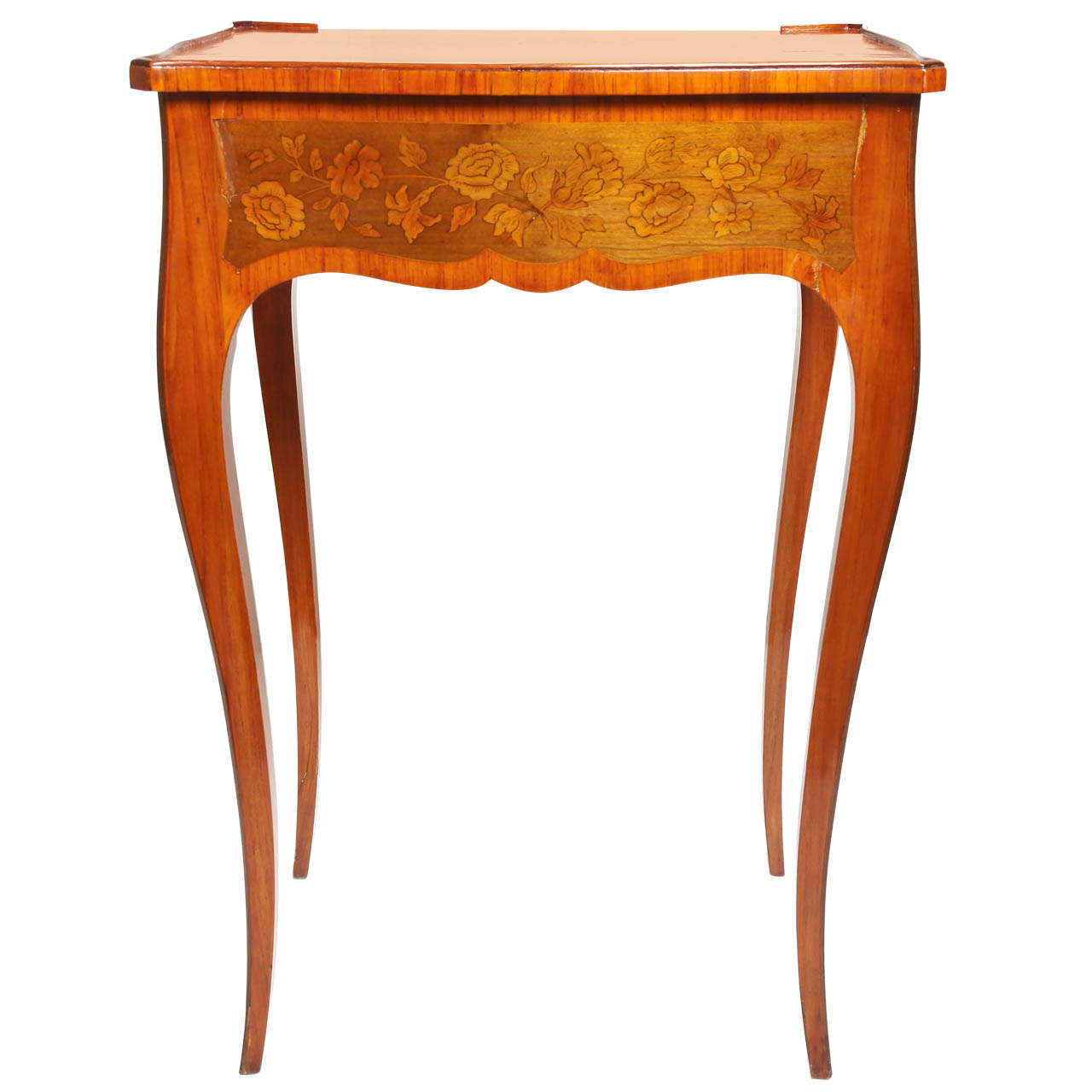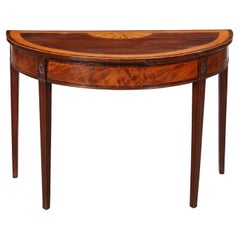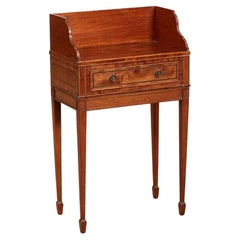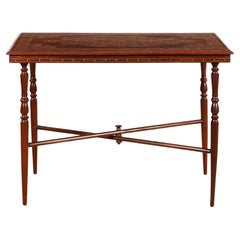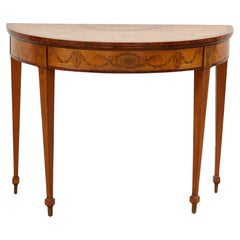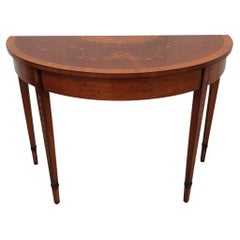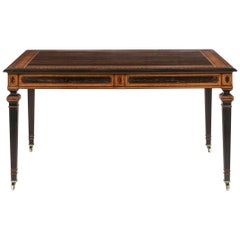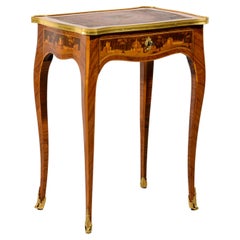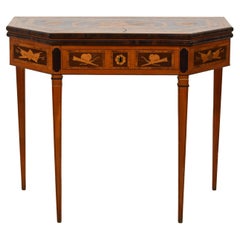Items Similar to Inlaid Serving Table Attributed to Ince and Mayhew
Want more images or videos?
Request additional images or videos from the seller
1 of 16
Inlaid Serving Table Attributed to Ince and Mayhew
$38,500
£29,842.69
€33,942.87
CA$55,176.31
A$60,499.17
CHF 31,627.27
MX$724,594.33
NOK 398,971.42
SEK 374,235.25
DKK 253,574.24
About the Item
A fine small mahogany inlaid serving table attributed to Mayhew and Ince, circa 1775 having a banded mahogany top set off with stringing and having a concave indentation above an inlaid frieze with faux fluting, the concave section with floral marquetry resting on six tapered and fluted legs with interesting blocking centered by rosettes in boxwood over shaped feet.
Provenance: Ex-Frank Partridge advertised in Arts and Decoration, Jan. 1941, Ex-Moss Harris advertised Country Life Feb. 2, 1957. Repairs to the left rear leg.
Ht. 33”, W. 47 1/8”, D. 25 3/4”
- Attributed to:Mayhew & Ince (Cabinetmaker)
- Dimensions:Height: 34 in (86.36 cm)Width: 48 in (121.92 cm)Depth: 27 in (68.58 cm)
- Materials and Techniques:
- Place of Origin:
- Period:
- Date of Manufacture:1785
- Condition:good original antique condition, Repairs to the left rear leg.
- Seller Location:Greenwich, CT
- Reference Number:Seller: YEWTR000017601stDibs: LU798345459822
About the Seller
5.0
Recognized Seller
These prestigious sellers are industry leaders and represent the highest echelon for item quality and design.
Platinum Seller
Premium sellers with a 4.7+ rating and 24-hour response times
Established in 1991
1stDibs seller since 2004
283 sales on 1stDibs
Typical response time: 1 hour
Associations
The Art and Antique Dealers League of AmericaAntiques Associations Members
- ShippingRetrieving quote...Shipping from: Bridgeport, CT
- Return Policy
Authenticity Guarantee
In the unlikely event there’s an issue with an item’s authenticity, contact us within 1 year for a full refund. DetailsMoney-Back Guarantee
If your item is not as described, is damaged in transit, or does not arrive, contact us within 7 days for a full refund. Details24-Hour Cancellation
You have a 24-hour grace period in which to reconsider your purchase, with no questions asked.Vetted Professional Sellers
Our world-class sellers must adhere to strict standards for service and quality, maintaining the integrity of our listings.Price-Match Guarantee
If you find that a seller listed the same item for a lower price elsewhere, we’ll match it.Trusted Global Delivery
Our best-in-class carrier network provides specialized shipping options worldwide, including custom delivery.More From This Seller
View AllGeorgian Inlaid Demilune Table
Located in Greenwich, CT
Fine George III purpleheart demilune console table with fine inlays, the top with satinwood, harewood, rosewood and holly fan inlay with rosewood and satinwood crossbanding, the apro...
Category
Antique 1780s English George III Console Tables
Materials
Mahogany, Purpleheart, Satinwood
Inlaid Mahogany Hall Table
Located in Greenwich, CT
A small occasional or hall table having a rectangular top with three-sided raised surround with scalloped sides on a drawer with double brass ring pulls above a plinth apron, standin...
Category
Early 20th Century English Edwardian End Tables
Materials
Mahogany
Inlaid Drinks Table
Located in Greenwich, CT
An Anglo-Indian drinks table having a rectangular sandalwood top with canted edge on a thin apron all elaborately inlaid with bone filigree, and standing...
Category
Antique Late 19th Century Indian End Tables
Materials
Sandalwood
$6,900
George III Inlaid Satinwood Card Table
By Mayhew & Ince
Located in Greenwich, CT
Very fine George III inlaid satinwood card table attributed to Mayhew and Ince, the top profusely inlaid with central shell, urns, swags, honeysuckle a...
Category
Antique 1780s English George III Game Tables
Materials
Kingwood, Satinwood, Tulipwood
Diminutive Inlaid Harewood Pembroke Table
Located in Greenwich, CT
Quirky and diminutive Pembroke table having profuse inlay on harewood (stained sycamore) ground. Charming and somewhat naïve, but sincere nonetheless.
Category
Antique 19th Century Georgian Drop-leaf and Pembroke Tables
Materials
Kingwood, Harewood, Holly
Inlaid Swedish Satinwood Console
Located in Greenwich, CT
Very fine Swedish 19th Century gilt bronze mounted center table in the manner of George Haupt. In mixed woods, the top with marquetry basket of flowers withing an oval on a satin bir...
Category
Antique 1850s Swedish Gustavian Center Tables
Materials
Bronze
You May Also Like
Fabulous Mid-20th Century Inlaid Demi Lune Table
Located in Dublin, IE
A fabulous quality mid-20th century hand-made mahogany demi-lune table. The cross banded and line inlaid moulded top with intricate marquetry inlay depicting an exquisite radiating fan accented with foliate motifs and a composition of centred ribbon bow detail...
Category
Mid-20th Century English Demi-lune Tables
Materials
Mahogany
19th Century Coromandel and Inlaid Table Attributed to Jackson & Graham
By Jackson & Graham
Located in London, GB
A magnificent library table
Attributed to Jackson & Graham
Of free standing rectangular form, constructed in coromandel, with inlays in thuya, ebony, boxwood, and honeysuckle; the fluted legs rising from square brass castor-shod feet; the frieze housing two lockable drawers fitted with rare ‘tamper proof’ Chubb locks and having quadrant moulded cedar lined interiors; the platform having a central panel of beautifully chosen matched coromandel veneers, with an outer guard border of a running pattern of stylised anthemions; the ebony edges having a thumb nail moulding,
circa 1865
The firm of Jackson & Graham established in 1836 by Thomas Jackson and Peter Graham at 37 Oxford Street London, and for the next fifty years produced predominately high quality furniture and represented Britain at many of the international exhibitions. Their clients included Queen Victoria, Napoleon III, the Grand Khedive of Cairo and the royal palace in Siam. They were particularly noted for their fine marquetry work, the use of Wedgwood plaques, rare woods, and fine casting of bronze mounts. They engaged the leading designers of the period, inter alia, Owen Jones, Bruce Talbert, Alfred Lorimer and Eugene Prignot. In the mid-1850s the workforce was recorded as 250, and by 1875, the company was employing 600 workers. They were feted exhibitors at many of the Great Exhibitions of the 19th century, and frequent prize winners. At the Paris International Exhibition of 1878, the furniture jury noted of them ‘ the workmanship is so perfect that even with the aid of a magnifying glass scarcely the slightest imperfection is to be found’. In 1885 the company was absorbed by Collinson and Lock, who continued their standard of excellence.
Charles Chubb was apprenticed as a blacksmith before starting business as a ships’ ironmonger in Winchester. Jeremiah soon joined the business, and by 1818 the brothers had branched out into lockmaking, founding the famous Chubb Company.
The business really got started when Jeremiah Chubb patented his new ‘detector lock’ in 1818. The lock was constructed so that if someone tried to pick it or open it with the wrong key it became inoperable. To make the lock work again the owner had to use a special key supplied with the lock. The aim of the detector lock was to prevent burglaries, and to warn the owner that someone had tried to break into their property.
The lock soon became popular, and sales of the Chubbs’ products increased even more when they won a government competition to design a lock that could only be opened using its own key. After the invention of the detector lock, the Chubbs decided to move to Wolverhampton, which already had an established lock making industry. By 1838 they were making 28,000 locks a year at their Wolverhampton factory. Another product was added to the Chubb range in 1835 when a patent was taken out for a burglar resistant safe, and in 1837 the Chubb safe...
Category
Antique 19th Century English Tables
Materials
Brass
19th Century, France Inlaid Wood Centre Table
Located in IT
19th Century, France inlaid wood centre table
This elegant centre table in inlaid wood was made in France in the early 19th century.
The rectangular top has shaped and wavy side...
Category
Antique Early 19th Century French Restauration Center Tables
Materials
Bronze
19th Century, English George III Inlaid Console and Game Table
Located in IT
19th Century, English George III Inlaid Console and Game Table
Measures: closed: cm W 92,5 x D 46,5 x H 78,5; open: cm W 92,5 x D 93 x H 76,5
This refined console table can be tra...
Category
Antique Early 19th Century English George III Game Tables
Materials
Wood
19th Century French Single Drawer Inlaid Side Table
Located in Dallas, TX
19th c French acajou mahogany side table with tulipwood inlay and a single drawer
Category
Antique 19th Century French Side Tables
19th Century Continental Marquetry Inlaid Center Table
Located in Atlanta, GA
A 19th century continental rectangular form center table featuring marquetry inlay with foliage, flowers, birds and figures. The ebonized boarder top above single large drawer in fri...
Category
Antique 19th Century European Center Tables
Materials
Boxwood, Fruitwood, Walnut
More Ways To Browse
Small Serving Table
Frank Partridge
Lute Tables
Maison Jansen Swan Console
Marble Tv Console
Mediterranean Console Table
Mid Mod Console
Minotti Dining Table
Murray Iron Works
Natchez Collection
Negroponte Console
Paul Cornet
Pink Jade Table
Poe Table
Queen Anne Marquetry Table
Rainbow Console
Ralph Lauren Marble Tables
Red Parsons Table
